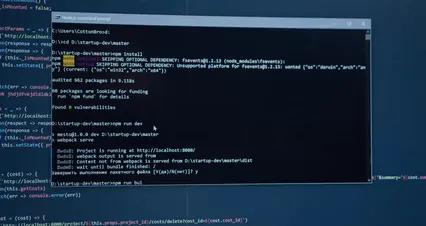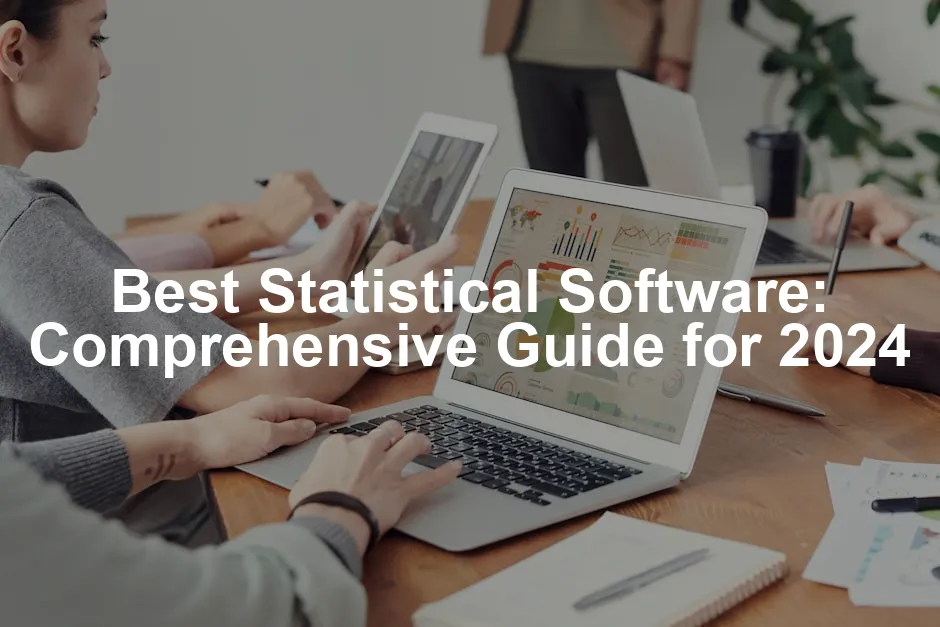Introduction
Statistical software plays a vital role in data analysis. These tools help simplify complex calculations and provide insights from large datasets. As industries increasingly rely on data-driven decisions, the need for effective statistical software has surged. This article aims to assist you in selecting the best statistical software to fit your needs.
If you’re looking to dive into the world of data analysis, consider picking up a book on R programming. It’s an essential skill for data analysis that will help you unlock the power of statistics in your projects!

Summary and Overview
Statistical software enables users to analyze and interpret data efficiently. These tools are essential for tasks like hypothesis testing, regression analysis, and data visualization. A wide variety of software options exist, catering to different skill levels and use cases. From user-friendly interfaces for beginners to advanced capabilities for experts, there’s something for everyone.
When evaluating statistical software, consider factors such as usability, features, and pricing. The best tools offer robust functionalities while remaining accessible. Current trends show a shift toward AI integration and enhanced user interfaces, making data analysis easier for non-technical users. In 2024, expect more innovations that streamline data handling and boost productivity. Tools like Data Visualization Tools: A Practical Guide can help you present your data effectively!

Top Statistical Software Options
Overview of the Best Statistical Software
As we step into 2024, several statistical software tools stand out for their capabilities and user-friendliness. Here’s a quick look at the top contenders:
- IBM SPSS Statistics: Ideal for social sciences, SPSS is known for its intuitive interface and robust data analysis features. Learn more about SPSS troubleshooting and solutions.
- R: This open-source programming language is favored by statisticians. It offers endless customization and a community-driven approach to data analysis. Consider checking out The Art of Data Science for deeper insights!
- MATLAB: Primarily used in engineering and data science, MATLAB excels in handling complex calculations and data visualizations.
- SAS: A go-to for industries like healthcare and finance, SAS provides comprehensive analytics tools and strong support. Explore in-depth analysis using SAS.
- Minitab: Tailored for Six Sigma professionals, Minitab simplifies quality improvement processes with its user-friendly interface.
- Stata: Best for econometric analysis, Stata is popular in social sciences due to its straightforward syntax and extensive documentation.
- JMP: Known for its interactive visualizations, JMP is designed for users who prefer a more hands-on approach to data exploration.

1. IBM SPSS Statistics
Overview
IBM SPSS Statistics stands as an industry standard for statistical analysis. It’s user-friendly, making it a great choice for both beginners and experienced analysts. SPSS is widely used across various domains, especially in social sciences and market research. Key features include ANOVA and multivariate analysis, enabling users to conduct complex statistical tests easily.
For those who want to explore more about statistical analysis, consider getting Data Science for Business. This book provides insights into applying data science principles in your business decisions!

Pros and Cons
- Pros:
- Intuitive interface for easy navigation.
- Extensive statistical modeling options.
- Strong community and customer support.
- Cons:
- Higher costs compared to some alternatives.
- Limited flexibility for advanced programming needs.
2. R
Overview
R is a powerful open-source language perfect for advanced users. It offers incredible flexibility and allows for extensive customization through packages and user-defined functions. R is backed by a vast community, ensuring continuous support and the latest statistical techniques. Its capabilities in data visualization are enhanced by packages like ggplot2, making it a favorite among data scientists.
If you’re keen to get started with Python, another essential tool for data analysis, I recommend Python for Data Analysis. This book is a fantastic resource for anyone looking to leverage Python in their data projects!

Pros and Cons
- Pros:
- Completely free and highly adaptable.
- Strong community support and resources.
- Excellent for complex data analysis and modeling.
- Cons:
- Steeper learning curve for beginners.
- Requires coding knowledge for full utilization.
3. MATLAB
Overview
MATLAB is widely used in engineering and data science. It excels in advanced calculations, making it perfect for complex mathematical modeling. With its extensive toolbox availability, users can tackle a variety of problems, from signal processing to machine learning. This software supports high-level programming and provides interactive visualizations. Engineers and researchers benefit from its powerful functions that streamline data analysis and visualization. Its robust capabilities make MATLAB a go-to for professionals across multiple disciplines.
For those who enjoy tinkering with hardware and software, the Raspberry Pi Starter Kit can be a great companion to explore programming and electronics!

Pros and Cons
- Pros:
- Excellent for numerical computation and modeling.
- Interactive tools for data visualization.
- Extensive library of toolboxes for various applications.
- Cons:
- Can be expensive for smaller teams.
- Steep learning curve for new users.
4. SAS
Overview
SAS is a well-respected name in the healthcare and finance sectors. Its robust analytics capabilities make it invaluable for large datasets. Many organizations trust SAS for its reliability and performance. Users appreciate its strong customer support, which aids in troubleshooting and optimization. SAS provides advanced analytical techniques, such as predictive modeling and data mining. As a result, it helps businesses make informed decisions backed by thorough data analysis.
To enhance your analytical skills, consider The Data Warehouse Toolkit. This book is a must-read for anyone looking to understand data warehousing concepts!

Pros and Cons
- Pros:
- Comprehensive analytics capabilities.
- Strong support network and resources.
- Ideal for handling large datasets efficiently.
- Cons:
- High licensing costs can be prohibitive.
- Steeper learning curve for beginners.
5. Minitab
Overview
Minitab focuses on Six Sigma and manufacturing processes. It’s designed to streamline quality improvement strategies. The software features a user-friendly interface that simplifies data analysis. With a variety of statistical tools, Minitab makes complex analyses accessible. Whether you’re assessing process variation or conducting hypothesis testing, it has you covered.
If you’re interested in improving your cooking skills while analyzing data, check out the Cookbooks for Healthy Eating. They can inspire you to cook delicious meals while you crunch those numbers!

Pros and Cons
- Pros:
- Excellent for Six Sigma projects.
- Intuitive interface for easy navigation.
- Comprehensive statistical tools and features.
- Cons:
- High cost may deter small businesses.
- Limited offline capabilities may be inconvenient.
6. Stata
Overview
Stata shines in econometrics and social science research. Its strengths lie in data manipulation and statistical analysis. The software offers a user-friendly design, making it approachable for beginners. Stata’s command options allow for flexibility in analysis, catering to both novice and experienced users.
For those looking to sharpen their statistical skills, consider exploring You Don’t Know JS book series. This series is great for anyone wanting to understand the intricacies of JavaScript, which can be beneficial in data science!

Pros and Cons
- Pros:
- Strong support for econometric modeling.
- User-friendly with extensive documentation.
- Excellent for handling large datasets.
- Cons:
- Pricing may be steep for some users.
- Less intuitive for those unfamiliar with command syntax.
7. JMP
Overview
JMP offers interactive visualizations that enhance data exploration. Its ease of use makes it popular among non-statisticians. Designed for engineers and scientists, JMP includes tools for various applications. Users can create dynamic graphs and charts, making presentations more impactful.
If you’re into self-care, consider investing in a Essential Oils Diffuser. It can help create a calming atmosphere while you work on your data projects!

Pros and Cons
- Pros:
- Highly interactive and visual interface.
- No coding skills required for basic analyses.
- Strong capabilities for exploratory data analysis.
- Cons:
- Some advanced features may be limited.
- Higher price point compared to basic alternatives.
Features to Consider When Choosing Statistical Software
When selecting statistical software, several key features can significantly impact your experience and outcomes.

- Data Visualization Capabilities: A good tool should offer robust data visualization options. Look for software that enables you to create interactive graphs, charts, and dashboards easily. This feature helps in presenting data in a clear manner, making it easier to interpret results.
- Statistical Analysis Methods Supported: Ensure the software supports the statistical methods you plan to use. Common methods include regression analysis, ANOVA, and hypothesis testing. A broader range of techniques allows for more versatile data analysis. Learn more about regression analysis methods.
- Integration with Other Tools: Check if the software can integrate with other applications you use. Compatibility with data sources like Excel, SQL databases, or cloud storage simplifies data import/export processes.
- User Support and Documentation: Strong customer support is essential. Look for software that provides extensive documentation, tutorials, and user forums. This support can be invaluable when troubleshooting or learning new features.
- Pricing Models: Consider the pricing structure. Some software offers free versions, while others may require one-time payments or subscriptions. Evaluate what fits your budget while also considering the features you need.

Trends in Statistical Software
The landscape of statistical software is evolving rapidly. Here are some emerging trends to watch for:
- AI and Machine Learning Integration: More statistical tools are adopting AI and machine learning capabilities. This integration allows users to automate data analysis and uncover patterns more effectively.
- Cloud-Based Solutions: Many providers are moving towards cloud-based platforms. This shift offers scalability and accessibility, enabling users to work from anywhere and collaborate easily.
- Enhanced User Interfaces for Non-Technical Users: Software developers are focusing on creating intuitive interfaces. This makes it easier for non-technical users to navigate and utilize advanced features without extensive training.
- Open-Source Software Options Gaining Popularity: Open-source tools like R and Python libraries are becoming increasingly popular. They offer flexibility and can be tailored to specific needs, appealing to budget-conscious users and those seeking customization.

Conclusion
Choosing the right statistical software is crucial for effective data analysis. Each tool has unique features that cater to different needs and expertise levels. By considering factors such as data visualization, analysis methods, and integration capabilities, you can find the best fit for your requirements. Explore the options discussed to enhance your data analysis capabilities and make informed decisions based on solid insights.

For those who love to stay organized, consider investing in a Desk Organizer. A tidy workspace can significantly boost your productivity!
Please let us know what you think about our content by leaving a comment down below!
Thank you for reading till here 🙂
All images from Pexels




